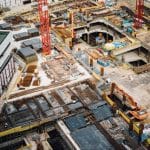As the pace of urbanization and technological advancement continues to accelerate, incorporating automated parking systems (APS) into commercial and residential buildings has become an increasingly viable solution for optimizing space utilization in real estate projects. This article explores the integration of automated parking systems in new real estate developments, discussing its advantages, how it works, and the key considerations in its design and implementation.
The Role of Automated Parking Systems in Real Estate Developments
In the context of urban development, parking systems are often overlooked, yet they play a crucial role in the overall functioning and aesthetics of a project. Cars take up a significant amount of space and can be a source of congestion and visual clutter. With their cutting-edge technology, automated parking systems come as a game-changing solution, transforming the way we think about and design parking spaces.
Also to read : What Are the Advantages of Passive House Standards in UK Home Building?
An APS is a mechanical system that transports cars from an entry point into a parking space without human intervention. By eliminating the need for traditional parking layouts, turning lanes, and wide ramping systems, APS provides a more space-efficient solution that can significantly reduce the land or underground area required for parking. This, in turn, allows for more creative use of available space, opening up opportunities for increased green areas, additional retail spaces, or more housing units.
Advantages of Integrating Automated Parking Systems in Building Projects
Integrating an APS into your building project can bring an array of benefits. Besides saving space, these systems can also enhance the overall security and user experience, providing a more comfortable and convenient parking solution.
Also read : What Are the Challenges of Balancing Heritage Preservation with Urban Development in Real Estate Projects?
Automated parking systems are particularly beneficial in urban areas where land is scarce and expensive. By maximizing parking space, developers can make more efficient use of their land, which can result in substantial cost savings. On the other hand, in residential buildings, an APS can provide tenants with a safer and more convenient parking experience. Since cars are parked in a controlled environment, the risk of theft or damage is significantly reduced. Furthermore, APS eliminates the need for drivers to navigate through narrow lanes and find a parking space, making parking a hassle-free experience.
How Automated Parking Systems Work?
Understanding how automated parking systems work is key to successfully integrating them into your real estate project. Upon arrival, the driver will park their car into a designated bay, exit the vehicle, and engage the system via a user-friendly interface. The APS will then take over, automatically transporting the car to a vacant parking space using a system of lifts, conveyors, and robotic platforms. When the driver returns, they simply need to request their car and it will be returned to the initial bay ready for them to drive away.
The technology behind APS is rapidly advancing and becoming more reliable. Some of the leading systems now use sophisticated sensors and Artificial Intelligence (AI) algorithms to optimize the parking process, ensuring the efficient use of space and minimizing the time it takes to retrieve parked cars.
Key Considerations in Designing and Implementing Automated Parking Systems
The integration of an APS into a real estate project requires careful planning and design. It’s critical to understand the needs of the end-users and to ensure the system can meet these needs effectively and efficiently. The following are some key factors to consider:
First, estimate the number of parking spaces required based on the projected number of users. This will depend on the nature of the building – a residential apartment block will likely have different parking needs compared to a commercial office building.
Next, consider the layout and design of the APS. It’s important to ensure the system is easy to use for drivers and that it blends seamlessly into the overall design of the building. It’s also crucial to plan for maintenance and potential system failures to minimize disruption to users.
Finally, it’s important to choose a reliable APS provider. Look for companies with a strong track record in the industry, who can provide high-quality systems and offer ongoing support and maintenance.
In conclusion, automated parking systems present a promising solution to the parking challenges in modern urban developments. They offer significant space-saving potential, enhance security, and provide a more convenient user experience. The successful integration of these systems into real estate projects hinges on careful planning, good design, and choosing a reliable system provider.
Integrating Automated Parking Systems: A Case Study of Los Angeles
Let’s dive deeper into the subject by examining a real-life example – the city of Los Angeles. Renowned for its notorious traffic congestion and lack of sufficient parking spaces, Los Angeles stands as the ideal candidate for the integration of automated parking systems in its new real estate projects.
Recent years have seen a surge in the adoption of automated parking garages in the city’s urban landscape. These parking garages are particularly popular in the downtown area, where land prices are sky-high. Through the use of robotic parking systems, these structures can house twice or even thrice the number of vehicles compared to a conventional parking garage of the same size. This efficient use of space translates into cost savings, both in terms of construction and land acquisition.
Take for instance the fully automated parking solution installed in a newly constructed residential tower in downtown Los Angeles. Here, residents simply leave their vehicle in a designated bay, and the automated parking system does the rest. Not only does this streamline the parking process, eliminating the stress of finding a parking space, but it also greatly enhances the user experience.
While there are significant benefits, the integration of these systems into real estate projects has not been without its challenges. In particular, parking management during the initial adoption phase required fine-tuning to ensure seamless operation. However, by selecting a reliable APS provider with a solid track record, these issues were swiftly addressed, showcasing the importance of thorough vendor selection.
Conclusion: The Future of Parking in Urban Developments
As we step further into the 21st century, our urban environments continue to evolve. Automated parking systems are set to play a crucial role in this transformation, revolutionizing the way we think about and manage parking solutions in new real estate projects.
The case of Los Angeles serves as an excellent example of how APS can significantly optimize space, enhance user experience, and reduce costs. However, the successful integration of these systems requires careful planning and design, as well as the selection of a reliable system provider.
In an era where space is at a premium, the effective use of automated parking systems in real estate developments is not just a viable option, but a necessity. As technology continues to advance, we can only expect these systems to become more efficient and user-friendly, making parking a far less daunting task in our everyday lives.
The future of urban spaces lies in solutions like these, ones that manage to marry convenience, security, and efficiency in a package that enhances the overall user experience. It’s safe to say that automated parking is here to stay, and will continue to be an integral part of our urban landscapes.











